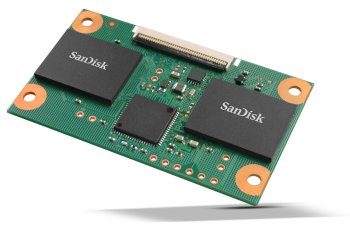SanDisk Corporation today unveiled its next-generation of flash memory-based solid-state drives (SSD) to support the evolving needs of designers, manufacturers and users in the exploding netbook market - SanDisk® pSSD™. The new SanDisk pSSD-P2 and SanDisk pSSD-S2 SSDs have capacity and performance for more full-featured netbooks which require a robust operating system.

Designed as drop-in replacements for hard-disk drives (HDDs), SanDisk’s new second generation module has a SATA interface to meet new netbook design requirements. The SATA interface offers a significant boost in performance rendering these SSDs faster than HDDs in critical aspects. Booting and launching applications takes just half the time of an HDD.
Available in capacities of 8, 16, 32 and 64-gigabytes (GB), SanDisk Gen 2 pSSD drives are aggressively priced, making them attractive for POS terminals, printers, ATMs and other applications where users need HDD functionality with strong reliability, yet want to pay a low cost for the exact capacity that they need. For example, the 32GB modular SSD is priced at parity with 2.5” HDDs in OEM quantities.
“Netbooks represent the fastest growing PC segment in 2009 and 2010 yet widespread adoption of SSDs in netbooks has been limited by speed, capacity and cost constraints,” said Rich Heye, senior vice president and general manager, Solid-State Drives (SSD), SanDisk. “With the significant improvements in performance, capacity and low pricing, these SSDs are a perfect fit for the exploding netbook market.”
SanDisk’s Gen 2 pSSD drives, slated to be available in February, 2009, are built using the company’s reliable 43-nanometer Multi-Level Cell (MLC) flash memory. This technology is produced at fabrication plants in Yokkaichi, Japan, where SanDisk and its partner, Toshiba Corporation, share the output.

